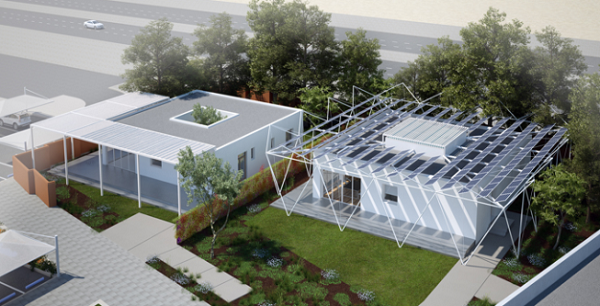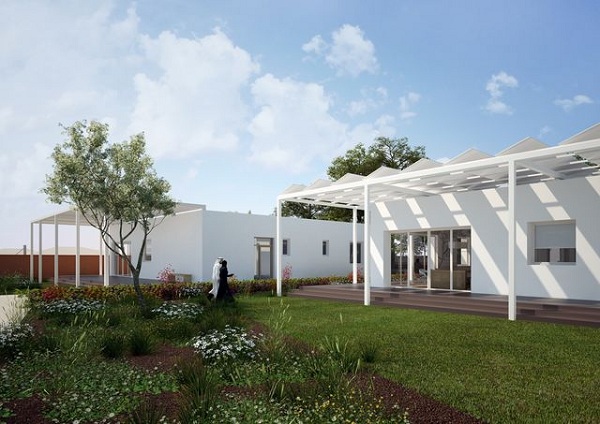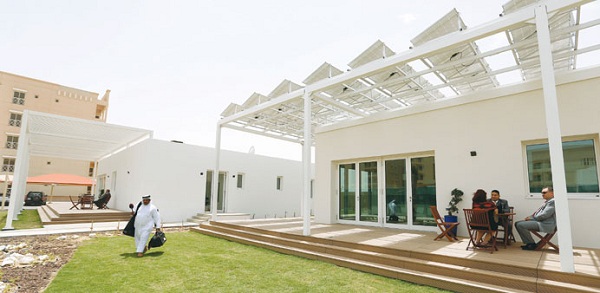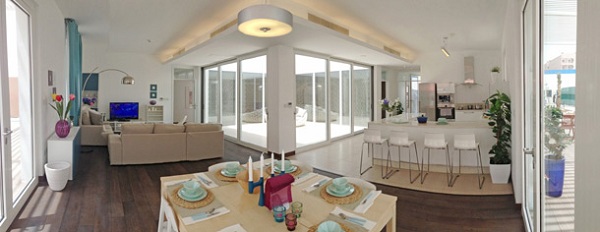Qatar has the highest carbon emissions per capita in the world; three times as high as the United States. According to the World Wildlife Fund, “if every human being lived like the average Qatari, the Earth would need nearly five times more resources than it has”.
Who can blame them? If you lived in the desert, wouldn’t you keep that AC blasting and plasma TV running 24/7 if your energy was free? That’s right, Qatar citizens get free electricity and free water, which the Guardian‘s Fred Pearce described in a 2010 column as “liquid electricity,” since water in the Middle East is often produced by desalinating seawater, an energy-intensive activity. To make matters worse, Qatar’s energy demand is rising by whopping 7 percent a year.
Enter the Baytna House
In order to curb its energy appetite, Qatar is now building its first ultra-low energy usage passive housing project in Doha. This experimental project, Baytna (our home in Arabic), is being undertaken by Qatar Green Building Council in partnership with Barwa Real Estate company.
One might only associate passive design with lower heating costs (as the home is passively heated by the sun) but the fact is these homes are so well insulated and sealed that they will require dramatically less energy to cool as well. They will also be designed to use 50% less water.
The project comprises of two 225 sq. m. (2400 square feet) villas, built side by side for a comparative study on benefits of the Passivhaus design in Qatar’s hot and arid climate. Decorated with 136 solar modules, the homes should generate enough electricity to sustain their needs, and even contribute additional energy back to the local grid. Several organizations are partnering on the project, including Qatar Solar Technologies.
The Qatari passive house study seeks to establish whether an eco-friendly villa can be a viable building option. Therefore, both homes will be occupied by families with an interest in sustainability but who are representative of a typical family in Qatar. The plan is to compare results of energy modeling and find ways to optimize the future projects. Can you smell a little competition? There is your new idea for a reality TV show.
Qatari Green Building Council hopes there will be number of similar homes in the near future. Some will be experimental and some will be developed by owners who have an interest in sustainability and want to demonstrate that they are committed.
Financial Benefits vs. Environmental Concern
One of the primary reasons sustainability efforts are spreading throughout the globe is because they make financial sense. Let’s face it, most people are driven by financial benefits and enjoy the sustainability part as an emotional reward.
So what’s to drive Qataris’ sustainability efforts if their energy is practically free? Besides a small truly idealistic population the true benefits might be hidden on the macro level. Turns out that the more Qatar reduces its carbon footprint internally via energy usage, the more attractive their oil becomes to the environmentally weary governments around the globe. According to Qatar’s Green building Council:
This is an important issue as a great deal of Qatar’s CO2 emissions are attributable to the production of oil and gas fuels which are exported to developed countries like the UK. Understanding that its CO2 footprint extends beyond its physical boundaries was one of the factors that prompted the UK Government to increase its carbon reduction commitment and which have now targeted an impressive 80% reduction of 1990 levels by 2050. If countries like the UK are prepared to accept that per capita CO2 should be derived by a consideration of actual UK consumption of all goods and services and that this is really the key CO2 indicator, then Qatar’s stance on emphasizing a consumption approach has great credence.
In short: building more passive houses will lower the country’s carbon footprint and pragmatically, allow the country to export more of its lucrative oil and gas abroad.




 Not Such Obvious Benefits of Oil Boilers
Not Such Obvious Benefits of Oil Boilers Who Really Wants to Pay You? Energy Efficiency Rebates, Incentives and Tax Credits
Who Really Wants to Pay You? Energy Efficiency Rebates, Incentives and Tax Credits Calaveras Home Showcases Modern Elements of Energy Efficiency and Finest Green Building
Calaveras Home Showcases Modern Elements of Energy Efficiency and Finest Green Building